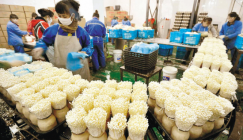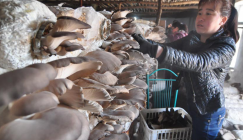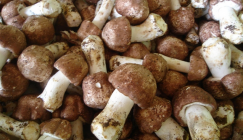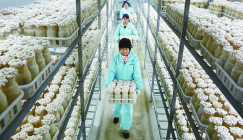King oyster mushroom, also known as Pleurotus eryngi and belongs to Hymenomycetes, is a kind of typical wild mushroom in subtropical grasslands and dry desert areas. From the late spring to the early summer, it becomes a kind of saprophytic fungus or facultative parasitism in the roots or the surrounding soil of large umbrella-type flower plants such as Eryngo and Ferula asafoetida. King oyster mushrooms are widespread in Germany, Italy, France, Hungary, India, Pakistan and other countries. They are also widespread in Sinkiang, Northern Sichuan Province, Qinghai Province and other places in China, belonging to a kind of large fleshy toadstool which are superior and high-quality, they possess hypertrophic context, abundant nutrition and the flavor of almond and abalone, hence are also called “Almond and Abalone mushroom”. The sporocarps hold white color, crisp texture and particularly enjoy good reputation of “The king of Oyster mushroom”, “Delicious Bolete on the grassland” and “Campoys mushroom”, King oyster mushroom is rich in balanced nutrition, it is a kind of high-protein, low-fat nutritional health products and being hailed as the ideal health food in the new century and is loved by customers.
The research of artificial cultivation on King oyster mushroom began in France, Italy and India. In China, the research started in 1993. In recent years, the domestic cultivation of King oyster mushroom has been developed quickly and has been transformed from seasonal cultivation to annual cultivation. King oyster mushrooms fruit in medium, low temperature and constant temperature and are largely influenced by natural conditions and seasons, people could only cultivate in early autumn and winter in accordance with natural climate conditions, which can’t meet civil needs on annual consumption. However, the industrialized cultivation way is to utilize cold warehouse to conduct artificial controlling on temperature, light, air and humidity, create the optimal environment for the growth of king oyster mushroom and sequentially realize its annual production.
Industrialized cultivation method of King oyster mushroom is actually to adopt modern industrial facilities to artificially simulate ecological environment in different climate conditions and in unit land areas, create environmental conditions that are fit for different growth periods, conduct three-dimensional, large-scale, round-the-clock and annual cultivation, gradually realize the intellectualization on the adjustment and controlling of production environment and realize the mechanization in production operation, raise the utilization rate of equipment and facilities, promote traditional mushroom production mode to upgrade into a kind of new-type, efficient, superior as well as advanced production mode which sets modern agricultural industrialization management into one, then realize the modernization of mushroom industry.
Over the last few years, the King oyster mushroom cultivation has been taking shape in China. Through the guidance of agricultural technical personnel, the non-pollution cultivation technology of local industrialized King oyster mushroom has been explored and put into application, which turns into a characteristic industry for farmers to generate revenue.
1. The environmental requirements on producing area: A. The producing area should be settled away from industrial park of food fermentation, livestock areas, hospital, residential areas and the place existing no “Three wastes” pollution sources.
B. With clean environment and air convection in surrounding areas of mushroom house.
C. Choose environmental-friendly calcium hypochlorite to conduct chemical sterilization, which facilitates quickly resolves substances which are harmless to the environment, human bodies and the production of King oyster mushroom after contacting with air.
D. Use ultraviolet lamp or physical disinfection method such as ozone sterilizer to replace chemical disinfection.
E. The area that is all around the producing field should be clear and opened to ensure good ventilation.
F. Lime should be scattered to replace chemical pesticides.
G. The source of water should be pollution-free, clean and be part of irrigation water. The soil quality should be in accordance with the requirements of non-pollution production.
2. The time of cultivation: King oyster mushroom belongs to medium and low temperature type, the temperature range of spawns growth is 8-32 degrees, the optimal temperature of spawn running is 22-24 degrees. Spawns turn into poor growth trend, malformed mushrooms are easy to happen when the temperature is higher than 30 degrees. The optimal temperature of primordium formation is 10-15 degrees. It is impossible to form sporocarps when the temperature is below 8 degrees. The temperature of sporocarp development varies from strain to strain. In general, the optimal range of temperature is 15-21 degrees. During the fruiting period in summer, people could control the temperature in under 23 degrees. However, industrialized cultivation could break the restriction on temperature, people could also utilize regulating devices such as temperature, humidity and light to realize annual production.
3. The selection of strain: choose varieties which are resistant to diseases and pests, good-quality and high-yield, hold strong stress resistance and good product performance. Strains should be free from sundry fungi, diseases and pests, present even and viable. The phenomenon of withering and drying should be avoided in the substrate. It is worth noting that the quality of strain plays a decisive role during the whole cultivation process.
4. The preparation of compost: composts that are used for cultivating King oyster mushroom should be nutritious, breathable and owns good water retention. What’s more, any detrimental impurities should not be contained in compost. It should be highlighted that polluted compost is inoperative in mushroom cultivation. Common main ingredients for compost are cottonseed hull, sawdust, corncob and so on. Common auxiliary materials are bran and gypsum. Common formulas are:
A. Sawdust 53%, cottonseed hull 20%, corncob powder 4%, Superphosphate 1%, sugar 1%, gypsum 1%.
B. Corncob 40%, sawdust 22%, bran stalk powder 10%, bran 20%, corncob flour 5%, Superphosphate 1%, gypsum 2%.
C. Corncob 35%, cottonseed hull 18%, sawdust 20%, bran 20%, corncob powder 5%, sugar 1%, Superphosphate 1%, gypsum 1%.
5. Bagging and spawn running: people could choose one of three formulas, but Formula C is usually preferred in industrialized production of King oyster mushroom. People could mix materials in a conventional way, control the PH Value in 7-8 and control the water content in 60%-65%, it is proper to choose polyethylene plastic bags with the specification of 15cm*35cm and the thickness of 0.045 to 0.05cm. People could seal one side, use bagging machine and put 0.9-1.0kg of materials in each bag. After that, people could press compost tightly, fold and seal, sterilize under high pressure steam of 126 degrees for 2 hours. After sterilizing, people could remove into buffer room to cool down. When finding that the temperature of material has cooled to about 30 degrees, remove into inoculation room to prepare for inoculation, then transfer into cultivation room and conduct lucifuge cultivation under the constant temperature of 22-25 degrees in fungi sacks with the relative air humidity of 60%-70%. What’s more, certain gaps should be left between each fungus sack to avoid the phenomenon of “Burning in fungus”. During the growth period of King oyster mushroom, oxygen dioxide facilitates promoting the growth of spawns, people could therefore give a small number of ventilation.
6. Fruiting management: in normal conditions, spawns become fully-grown after 27 to 30 days. Then, spawns reach physiological maturity after passing the after-mature cultivation of about 10 days when people find that yellow liquid is continuously secreting on both sides of fungi sack, on that occasion, remove fungi sacks into the fruiting room to arrange budding and fruiting. Moreover, vertical shelves are generally adopted and it is improper to place fungi sacks tightly for fear of affecting the yield. In addition, the fruiting room should be thoroughly ventilated and dried before using, thorough disinfection should also be followed up.
During the period of bud-inducing, control the temperature in 13-15 degrees, control relative air humidity in 80%-90%, 1000 LX of scattered light should be moderately increased, 2-3 times of ventilation should be given per day and each time should be remained about 30 minutes. After 7 to 10 days, primordiums form and differentiate into tiny buds, on that occasion, be sure to unfasten the mouth of fungi sacks. During the growth period of tiny buds, control the temperature in 12-18 degrees, increase relative air humidity in 90%-95% and strengthen the light intensity in 500-600 LX. After 2-4 days, tiny buds gradually differentiate into tiny mushrooms. What’s more, in order to improve the commodity value of King oyster mushroom, 2 or 3 mushroom buds that are robust and with good appearance are generally left in each fungi sack. Certain gaps should also be left between each mushroom, which is beneficial for keeping good figures.
During the growth period of tiny mushrooms, keep stable temperature, moisture, air and moderately strengthen the light intensity to 800 LX. Mature period will approach in about 2 days later, during this period, keep the temperature in about 16 degrees, keep relative air humidity in 85%-90%, weaken the light to 500 LX, increase ventilation and avoid direct wind holding larger temperature difference.
7. Picking and process: mushroom buds could be picked after about 6 days of cultivation. It is the best picking time when people observe that mushroom caps are involute and haven’t become flat, lamella is about to discharge spores. When picking mushrooms, hold the base of stipe on sporocarp with hands, gently rotate and bring down. In general, 1 day before picking, stop spraying atomized water to the inside of greenhouse in attempts to lower the humidity of greenhouse, keep dry surface of sporocarps, enhance the quality of King oyster mushroom and extend the period preservation. After that, cut and trim the compost carrying with stipes base, then, it is time toconduct packaging and marketing in accordance with mushroom grades. People could also put them in the refrigeration house of 1-4 degrees for preservation. King oyster mushrooms possess dense structure, low water content, thick texture and are fit for long-distance transportation. In addition, they are difficult to change colors and are fit to be cut in slices, after lengthways cutting and cross cutting, it is proper to put them in the oven of 45-75 degrees, and then finished products could be made.
8. Prevention first, integrated control on diseases and pests: people could strictly select strains which hold the capacity of getting high yield and own strong stress resistance. Before using mushroom house, conduct disinfection and sterilization, all the tools should be timely and cleanly washed and disinfected. Wasted materials should be shipped to the place where is far away from mushroom house. The optimal environmental condition fitting for the growth of King oyster mushroom should be created.
For sciarids, it is feasible to utilize electric light and sticky coloured card to trap and kill. During the cultivation period of fungi sacks, check on them as early as possible. When finding pests during the fruiting period, people could adopt light trap and other physical methods to trap and kill them. Lastly, it is worth mentioning that any toxic or detrimental chemical drugs are strictly prohibited to be directly sprayed on mushroom bodies.

 LATEST NEWS
LATEST NEWS
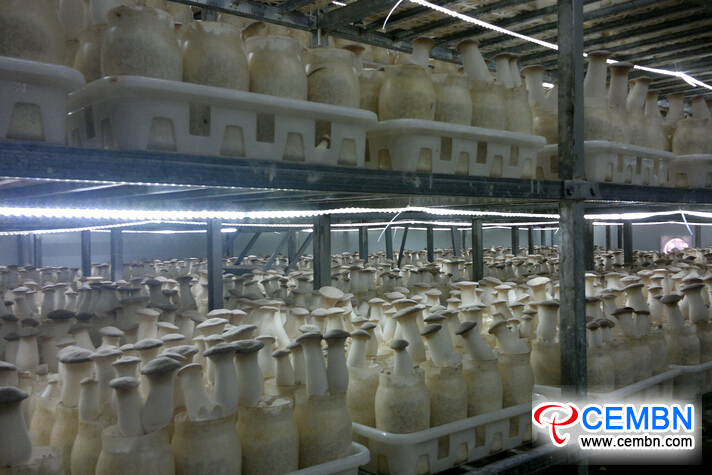
 MOST POPULAR
MOST POPULAR
